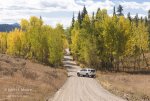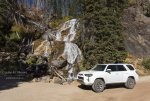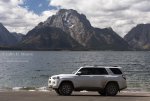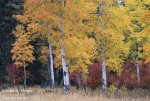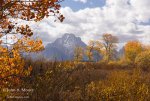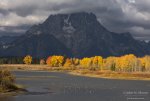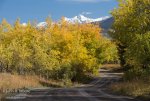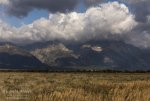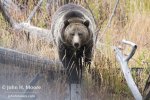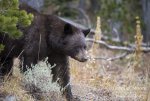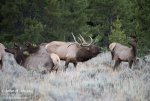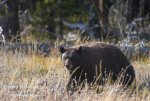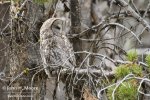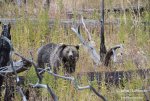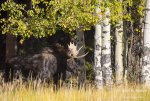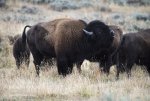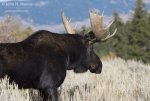Am recently home from a solo 3-week experiment traveling in Wyoming & Montana. Was it an "expedition"? -- definitely not by the definition in this forum! Was it "overlanding"? -- I'm really not sure, but probably not! It was my first experiment in traveling & living out of my new 4Runner for multiple weeks... and I loved it!
I'm a long-time nature photographer and traveler around mostly the western United States for photography, but have never had a good offroad vehicle. So where I can get to has been limited. I've often driven non-offroad vehicles places that I probably shouldn't have, but haven't pushed my luck too too far! I bought a 2018 Toyota 4Runner TRPORP this summer and noow I can start pushing my luck.
I live in San Diego and have come to love Wyoming--particularly the Jackson Hole / Grand Teton area. In August 2017, I was there for two weeks--week 1 with my family and staying in a hotel during the total solar eclipse, then for week 2 my family flew home, I kept the family minivan, camped, and tried my hand at photographing some of the big animals found in that area. I tend to say that I'm not an animal photographer, but that's not true--I'm not a terrestrial animal photographer. I've been an underwater photographer for years--photographing marine animals--as well as a landscape photographer, but have never focused on land animals. After last year's week trying big-animal photography, I set my sights on spending a month in Wyoming and Montana in 2018 around the fall rut. As fall got closer, that was unfortunately trimmed to 3 weeks, but it was still a great trip.
I bought my 4Runner in June and have not made any modifications to it at this point. I'm doing a lot of reading and thinking about how I want to use it, and will start making changes sometime next year. For this trip, the vehicle was stock. I lived out of the 4Runner for 21 nights and put 4,700 miles on it during this trip. From San Diego up to Jackson, many miles around Grand Teton National Park (where I explored as many unpaved roads as I could find!) & Yellowstone NP, then up to Flathead Lake in Montana, back to Wyoming, then back to San Diego. Skalkaho Pass in Montana was just gorgeous. I had hoped to take several more passes, including Beartooth Highway, but literally the night before that part of the trip was to start the weather changed and snow started in the mountain passes. One of the passes I wanted to take was closed; I don't think that Beartooth was closed, but I decided to play it safe and save it for next time.
For the 4Runner,
- Sleeping: I bought a 3-inch memory foam mattress topper at Costco (queen size), folded it in half lengthwise over itself to make it 6 inches thick, and slept on that. I brought my winter sleeping bag as well as a heavy down comforter. The down comforter was used during the day to cover camera gear and keep it out of sight, and on the colder nights I added it on top of the winter sleeping bag. Coldest night was 22 degrees. The mattress topper was quite comfortable.
- Navigation: When out of cell service, mapping was a Garmin Inreach tied to Gaia GPS on an iPad. This generally worked well, though I've got a couple beefs with Gaia's map download system. I also used the Inreach every night to send an "I'm OK and at [coordinates]" back to my wife & kids--just so that they knew that I'd gone to bed and where I was.
- Food: I don't have a fancy overlanding refrigerator and stove setup (though it's high on the list of things I'm thinking about for before next year's adventure). Ultimately, as I prepared for this trip, I decided that between my bed inside the 4Runner, emergency gear, and all my photography gear (and there was a lot of it!), there really wasn't room for cooking & the food and equipment that require. So I pared the food part of the trip down to dehydrated meals and a very compact JetBoil stove. I ate 2/3rds of the meals on the trip from my car, but the food only took up the second-row footwell where I had removed the 4Runner seat bottom (so that the rear bed of the vehicle was long enough for me to sleep). I put a plastic bin in that footwell to provide support for the head end of my mattress/bed and managed to fit all the dehydrated meals into that bin--which then was completely out of sight and out of the main area in the back of the vehicle
In the back of the 4Runner, the bed area took up the passenger side. On the driver's side, I had
- Back: Flat bin with emergency gear (tire repair, compressor, first aid, tools, etc); larger bin with assorted photography and travel items (e.g., binoculars, LED light panels, spare batteries... and a whole lot of other stuff!); three tripods and a camp chair between the big bin and the outer wall of the vehicle.
- Next was six 1-gallon waters that were my emergency supply--not opened for regular use; I had other waters elsewhere that I used and refilled as I went
- Next my duffel with clothes. I used pay showers and did laundry twice a week.
- Next my big camera bag with all the lenses, camera bodies, etc. And my backpack with laptop and notebooks.
The vehicle felt to me like it ended up with just the right amount of stuff. If I'd tried to bring cooking gear and more food, it would have been too much. So I was happy with my choice for dehydrated food.
Overall it was a great experiment. I loved being able to explore down bad roads and I slept pretty well for the 21 nights. I did end up rigging up some curtains to hang on either side in the back--more for a combination of my peace of mind (I'd rather not see the bear looking in at me!) as well as blocking the light from the full moon that occurred during my trip.
Things I definitely want to change before the next adventure:
- Better curtains all around
- Better tires
Other things that I am thinking about:
- building a platform for the mattress so that I can store things underneath the platform
- refrigerator and stove
Well, I hope this was mildly interesting! Call it poor man's overlanding... Or the first step in a process... as I learn how to use my vehicle for adventures and live in it...
Photos to follow.
I'm a long-time nature photographer and traveler around mostly the western United States for photography, but have never had a good offroad vehicle. So where I can get to has been limited. I've often driven non-offroad vehicles places that I probably shouldn't have, but haven't pushed my luck too too far! I bought a 2018 Toyota 4Runner TRPORP this summer and noow I can start pushing my luck.
I live in San Diego and have come to love Wyoming--particularly the Jackson Hole / Grand Teton area. In August 2017, I was there for two weeks--week 1 with my family and staying in a hotel during the total solar eclipse, then for week 2 my family flew home, I kept the family minivan, camped, and tried my hand at photographing some of the big animals found in that area. I tend to say that I'm not an animal photographer, but that's not true--I'm not a terrestrial animal photographer. I've been an underwater photographer for years--photographing marine animals--as well as a landscape photographer, but have never focused on land animals. After last year's week trying big-animal photography, I set my sights on spending a month in Wyoming and Montana in 2018 around the fall rut. As fall got closer, that was unfortunately trimmed to 3 weeks, but it was still a great trip.
I bought my 4Runner in June and have not made any modifications to it at this point. I'm doing a lot of reading and thinking about how I want to use it, and will start making changes sometime next year. For this trip, the vehicle was stock. I lived out of the 4Runner for 21 nights and put 4,700 miles on it during this trip. From San Diego up to Jackson, many miles around Grand Teton National Park (where I explored as many unpaved roads as I could find!) & Yellowstone NP, then up to Flathead Lake in Montana, back to Wyoming, then back to San Diego. Skalkaho Pass in Montana was just gorgeous. I had hoped to take several more passes, including Beartooth Highway, but literally the night before that part of the trip was to start the weather changed and snow started in the mountain passes. One of the passes I wanted to take was closed; I don't think that Beartooth was closed, but I decided to play it safe and save it for next time.
For the 4Runner,
- Sleeping: I bought a 3-inch memory foam mattress topper at Costco (queen size), folded it in half lengthwise over itself to make it 6 inches thick, and slept on that. I brought my winter sleeping bag as well as a heavy down comforter. The down comforter was used during the day to cover camera gear and keep it out of sight, and on the colder nights I added it on top of the winter sleeping bag. Coldest night was 22 degrees. The mattress topper was quite comfortable.
- Navigation: When out of cell service, mapping was a Garmin Inreach tied to Gaia GPS on an iPad. This generally worked well, though I've got a couple beefs with Gaia's map download system. I also used the Inreach every night to send an "I'm OK and at [coordinates]" back to my wife & kids--just so that they knew that I'd gone to bed and where I was.
- Food: I don't have a fancy overlanding refrigerator and stove setup (though it's high on the list of things I'm thinking about for before next year's adventure). Ultimately, as I prepared for this trip, I decided that between my bed inside the 4Runner, emergency gear, and all my photography gear (and there was a lot of it!), there really wasn't room for cooking & the food and equipment that require. So I pared the food part of the trip down to dehydrated meals and a very compact JetBoil stove. I ate 2/3rds of the meals on the trip from my car, but the food only took up the second-row footwell where I had removed the 4Runner seat bottom (so that the rear bed of the vehicle was long enough for me to sleep). I put a plastic bin in that footwell to provide support for the head end of my mattress/bed and managed to fit all the dehydrated meals into that bin--which then was completely out of sight and out of the main area in the back of the vehicle
In the back of the 4Runner, the bed area took up the passenger side. On the driver's side, I had
- Back: Flat bin with emergency gear (tire repair, compressor, first aid, tools, etc); larger bin with assorted photography and travel items (e.g., binoculars, LED light panels, spare batteries... and a whole lot of other stuff!); three tripods and a camp chair between the big bin and the outer wall of the vehicle.
- Next was six 1-gallon waters that were my emergency supply--not opened for regular use; I had other waters elsewhere that I used and refilled as I went
- Next my duffel with clothes. I used pay showers and did laundry twice a week.
- Next my big camera bag with all the lenses, camera bodies, etc. And my backpack with laptop and notebooks.
The vehicle felt to me like it ended up with just the right amount of stuff. If I'd tried to bring cooking gear and more food, it would have been too much. So I was happy with my choice for dehydrated food.
Overall it was a great experiment. I loved being able to explore down bad roads and I slept pretty well for the 21 nights. I did end up rigging up some curtains to hang on either side in the back--more for a combination of my peace of mind (I'd rather not see the bear looking in at me!) as well as blocking the light from the full moon that occurred during my trip.
Things I definitely want to change before the next adventure:
- Better curtains all around
- Better tires
Other things that I am thinking about:
- building a platform for the mattress so that I can store things underneath the platform
- refrigerator and stove
Well, I hope this was mildly interesting! Call it poor man's overlanding... Or the first step in a process... as I learn how to use my vehicle for adventures and live in it...
Photos to follow.

